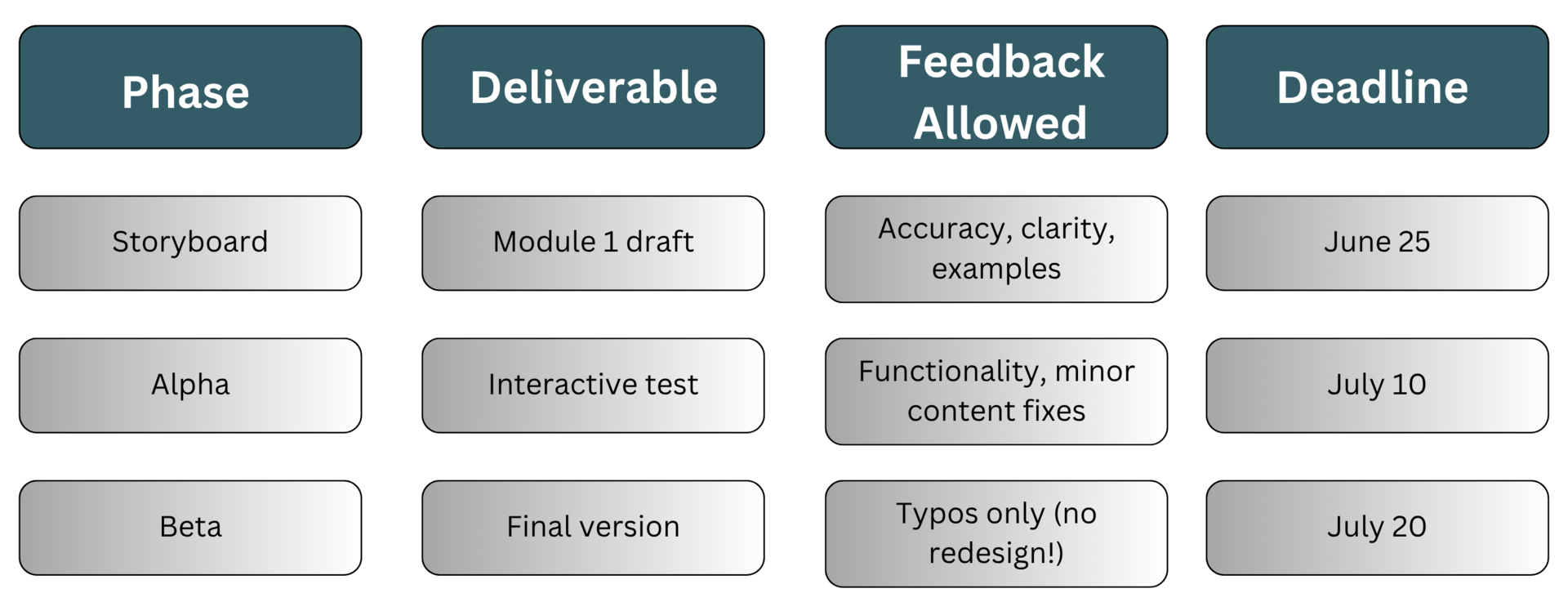eLearning Projects: How To Work Well With SMEs
Working with Subject Matter Experts (SMEs) is part of the job when you're creating eLearning. But let's be honest: it's not always easy. Sometimes they give great insights. Other times, they ask to change things that were already approved, or they focus on tiny details that don't impact learning at all. So how can we stay on track, keep things smooth, and still make them feel heard during our collaboration with SMEs?
Set Rules From Day One
Start your project with a clear review matrix to set expectations and avoid confusion later on. This simple solution outlines:
- What SMEs should review
Be specific: are they reviewing raw content, storyboards, visuals, or the final module? Define exactly which parts need their attention. - When they should review it
Set deadlines for each review phase, and explain how late feedback can delay the project. A shared timeline helps everyone stay aligned. - What kind of feedback is welcome
Guide them to focus their input on content accuracy, clarity, and learner relevance, not on design elements or formatting unless requested.
Here is an example of a review matrix:

Freeze What's Been Approved
Once something is approved, like the storyboard or visual design, it's locked. Here's a discussion example to make it clearer:
SME: "Let's change the whole color scheme!"
Instructional Designer: "Thanks for the idea! Since visuals were approved earlier, we'll consider that for the next version."
Show SMEs How To Review
Most Subject Matter Experts aren't familiar with Instructional Design, so it's helpful to guide them in how to give effective feedback. To make collaboration smoother, create a brief, simple resource, like a short PDF or a few slides, that explains:
- What Instructional Designers do
Outline your role in shaping content, structuring learning experiences, and ensuring engagement and clarity. - What kind of feedback is useful
Highlight feedback that improves learning objectives, accuracy, clarity, or learner engagement. - What's outside their scope
Clarify which issues are better left to the design team, such as graphic layout decisions, technical platform details, or project timelines.
Track Feedback (And Show What You Did With It)
Use a feedback tracker so everyone can see what's accepted, declined, or postponed. Here is an example template:

Have Friendly Responses Ready
When replying to SME feedback, it's important not to come across as defensive. Your goal is simply to explain the current status and reasoning clearly and respectfully. For example, you can acknowledge their input positively by saying, "Thanks! That's a great suggestion for a future update."
If the timing doesn't allow changes, gently set boundaries like, "We've passed the point where layout changes are possible, but we'll log it for later." Or focus on priorities by explaining, "Right now we're focused on content accuracy. We'll revisit visuals at a later stage." Using this kind of language helps keep the conversation constructive and maintains good collaboration with your SMEs.
Debrief With Your Team After Reviews
Every time you receive feedback from SMEs, take 15 minutes with your team to carefully review it together. First, identify which comments are valid and genuinely helpful; these are the points that improve the quality, accuracy, or clarity of your eLearning content.
Next, separate out any feedback that seems off-topic, outside the project scope, or unrelated to the learning objectives. This step helps you maintain focus and avoid unnecessary changes.
Finally, decide as a team how you will respond to the feedback. Plan clear, respectful replies that acknowledge the SME's input while gently explaining any limitations or reasons for not incorporating certain suggestions. This thoughtful approach ensures smooth communication and keeps the project moving forward efficiently.
Recap
- Set clear review rules
Use a feedback matrix to define what type of input is needed at each stage of the project. - Explain how to review
Guide SMEs on what to focus on, such as learning impact, accuracy, or structure, in order to avoid off-topic comments. - Track feedback in one place
Centralize all comments in a shared document or tool to prevent things from getting lost or repeated. - Freeze approved work
Once a section is validated, lock it to avoid unnecessary backtracking and scope creep. - Use kind, clear replies
Acknowledge SME input respectfully, even when pushing back or explaining constraints. - Debrief after reviews
Take time to reflect together on what went well and what could be improved for the next round.
Final Words: Collaboration With SMEs
Managing SME feedback is all about clarity, boundaries, and mutual respect. By setting clear expectations from the start, you help avoid confusion and misalignment down the line. When feedback does come in, whether it's helpful, late, or off-topic, responding with patience and kindness can go a long way in maintaining a positive working relationship.
This not only builds trust but also creates a collaborative environment where everyone feels heard. Most importantly, it helps keep your eLearning project on track, on time, and aligned with its learning goals.
Image Credits:
- The images within the body of the article were created and supplied by the author.









